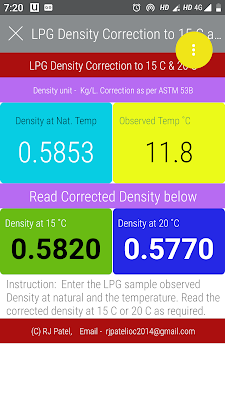An App for Prediction of C3 and C4 components of LPG from its density and RVP based on ASTM D2598

Earlier following posts detailing the methodology of estimating approximate C3 and C4 components of LPG from density@15C and RVP figures are published recently. Estimation of C3 & C4 percentage in LPG from Density & Estimation of C3 & C4 percentage in LPG from Vapor Pressure Similar Apps on Petroleum Calculations developed by RJ Patel- see here. Now an App based on above and ASTM D2598 is published. Steps : 1) Enter Density at 15 C or/and Vapor Pressure @ 37.8C of LPG 2) Read below C3 and C4 with assumption of C2 and C5 impurities =1 % V. Prediction of C3 & C4 components of LPG Mobile App Prediction of C3 - C4 Components of LPG - App as seen in Laptop/PC You can see other Apps of LPG based on ASTM D2598 at following: An App for Calculation of Vapor pressure of Liquefied Petroleum (LP) Gases from Compositional Analysis based on ASTM D2598. An App for Calculation of Relative Density of LPG from Compositional Analysis bas





